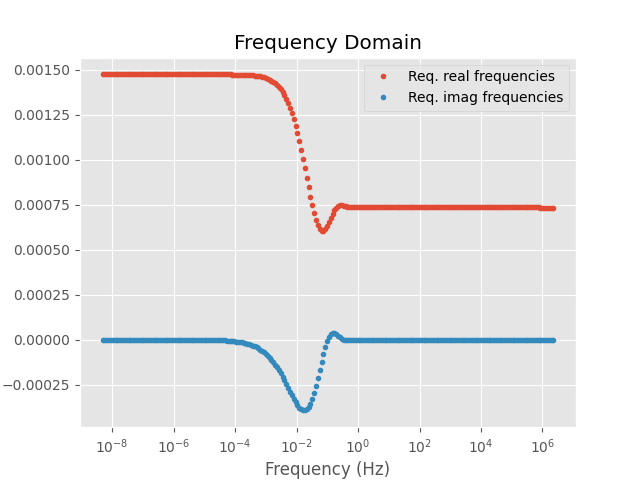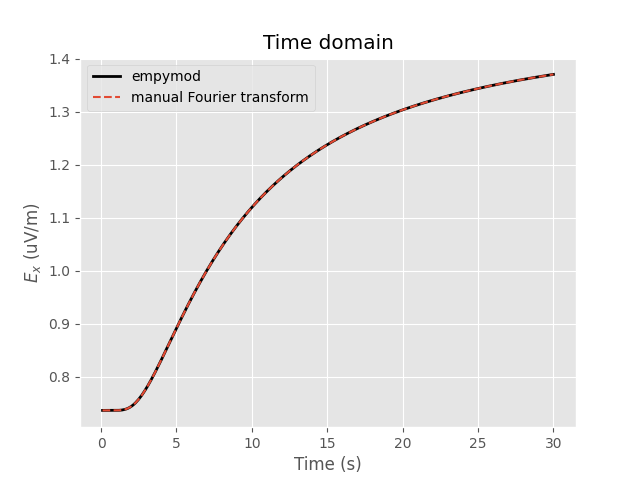Note
Go to the end to download the full example code
Transform utilities within empymod for other modellers#
This is an example how you can use the Fourier-transform tools implemented in
empymod with other modellers. You could achieve the same for the Hankel
transform.
empymod has various Fourier transforms implemented:
Digital Linear Filters DLF (Sine/Cosine)
Quadrature with Extrapolation QWE
Logarithmic Fast Fourier Transform FFTLog
Fast Fourier Transform FFT
For details of all the parameters see the empymod-docs or the function’s
docstrings.
import empymod
import numpy as np
import matplotlib.pyplot as plt
plt.style.use('ggplot')
Model and transform parameters#
The model actually doesn’t matter for our purpose, but we need some model to show how it works.
# Define model, a halfspace
model = {
'src': [0, 0, 0.001], # Source at origin, slightly below interface
'rec': [6000, 0, 0.001], # Receivers in-line, 0.5m below interface
'depth': [0], # Air interface
'res': [2e14, 1], # Resistivity: [air, half-space]
'epermH': [0, 1], # Set el. perm. of air to 0 because of num. noise
}
# Specify desired times
time = np.linspace(0.1, 30, 301)
# Desired time-domain signal (0: impulse; 1: step-on; -1: step-off)
signal = 1
# Get required frequencies to model this time-domain result
# => we later need ``ft`` and ``ftarg`` for the Fourier transform.
# => See the docstrings (e.g., empymod.model.dipole) for available transforms
# and their arguments.
time, freq, ft, ftarg = empymod.utils.check_time(
time=time, signal=signal, ft='dlf', ftarg={}, verb=3)
time [s] : 0.1 - 30 : 301 [min-max; #]
Fourier : DLF (Sine-Filter)
> Filter : key_201_2012
> DLF type : Lagged Convolution
Frequency-domain computation#
=> Here we compute the frequency-domain result with `empymod`, but you could compute it with any other modeller.
fresp = empymod.dipole(freqtime=freq, **model)
:: empymod END; runtime = 0:00:00.023251 :: 1 kernel call(s)
Plot frequency-domain result

Fourier transform#
# Compute corresponding time-domain signal.
tresp, _ = empymod.model.tem(
fEM=fresp[:, None],
off=np.array(model['rec'][0]),
freq=freq,
time=time,
signal=signal,
ft=ft,
ftarg=ftarg)
tresp = np.squeeze(tresp)
# Time-domain result just using empymod
tresp2 = empymod.dipole(freqtime=time, signal=signal, verb=1, **model)
Plot time-domain result

empymod.Report()
Total running time of the script: (0 minutes 1.462 seconds)
Estimated memory usage: 10 MB